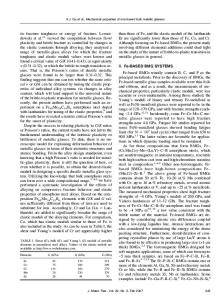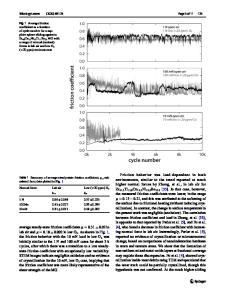Formation and properties of Pr-based bulk metallic glasses
- PDF / 148,485 Bytes
- 6 Pages / 612 x 792 pts (letter) Page_size
- 110 Downloads / 331 Views
The data on the compositional dependence of glass-forming ability, glass transition, and properties of bulk metallic glasses (BMGs) are important for understanding the nature and glass-forming ability of metallic glasses and for their application. In this paper, we report the formation of rare-earth-based Pr–(Cu,Ni)–Al pseudo-ternary BMGs with a large bulk glass-forming composition range and distinct glass transition. The compositional dependence of glass-forming ability, glass transition, and properties were systematically studied. The contrasting effects of Al and Pr on glass formation and glass transition, unique elastic properties, and phonon softening of the BMGs are discussed from the structural point of view.
I. INTRODUCTION
During the past decade, intensive efforts have been made to investigate the magnetic rare-earth-transition metal-based (RE-TM) bulk metallic glasses (BMGs).1–3 However, unlike others, some RE-TM-based BMGs have neither a distinct glass transition nor a large supercooled liquid region in their differential scanning calorimetry (DSC) traces,4 although glassy samples with large diameter can be prepared. It was first believed that a glass transition temperature too close to the crystallization onset temperature might be the primary reason for this. Later, careful microstructural investigations showed that these RE-TM-based BMGs, such as NdFeAl(Co), are actually a mixture of nanocrystalline clusters and glassy matrix.5 Recently, a series of different RE-TM-based BMGs, which have a distinct glass transition and a fully glassy structure, have been developed.6–9 Independently, Zhao et al.6–8 and Zhang et al.9 have reported that full bulk amorphous Pr-based alloys can be formed. The excellent glass-forming ability (GFA), stable supercooled liquid region, distinct glass transition, and, especially, the large glass-forming composition range make these BMGs ideal candidates to investigate the compositiondependent GFA, physical properties, and glass transition. The BMGs are also promising for future applications.3,6–9 To guide the development of BMGs, various criteria have been proposed.10–13 Turnbull10 predicted that as the ratio of the glass transition temperature Tg to the liquidus temperature Tl of an alloy (referred to as the reduced glass transition temperature Trg ⳱ Tg/Tl) increased to a)
Address all correspondence to this author. e-mail: [email protected] DOI: 10.1557/JMR.2006.0067 J. Mater. Res., Vol. 21, No. 2, Feb 2006
http://journals.cambridge.org
Downloaded: 13 Mar 2015
values near 2/3, the homogeneous nucleation of the undercooled melt should become very sluggish on the experimental time scale, and formation of BMGs should be possible. Inoue et al.12 developed three empirical rules to guide the formation of BMGs. Liu et al.13 recently proposed a new criterion of ␥ [␥ = Tx/(Tg + Tl)], where Tx is the crystallization temperature. However, with the development of BMGs, there is increasing evidence that these criteria are not consistent with all experimental results. Study of the crit
Data Loading...











